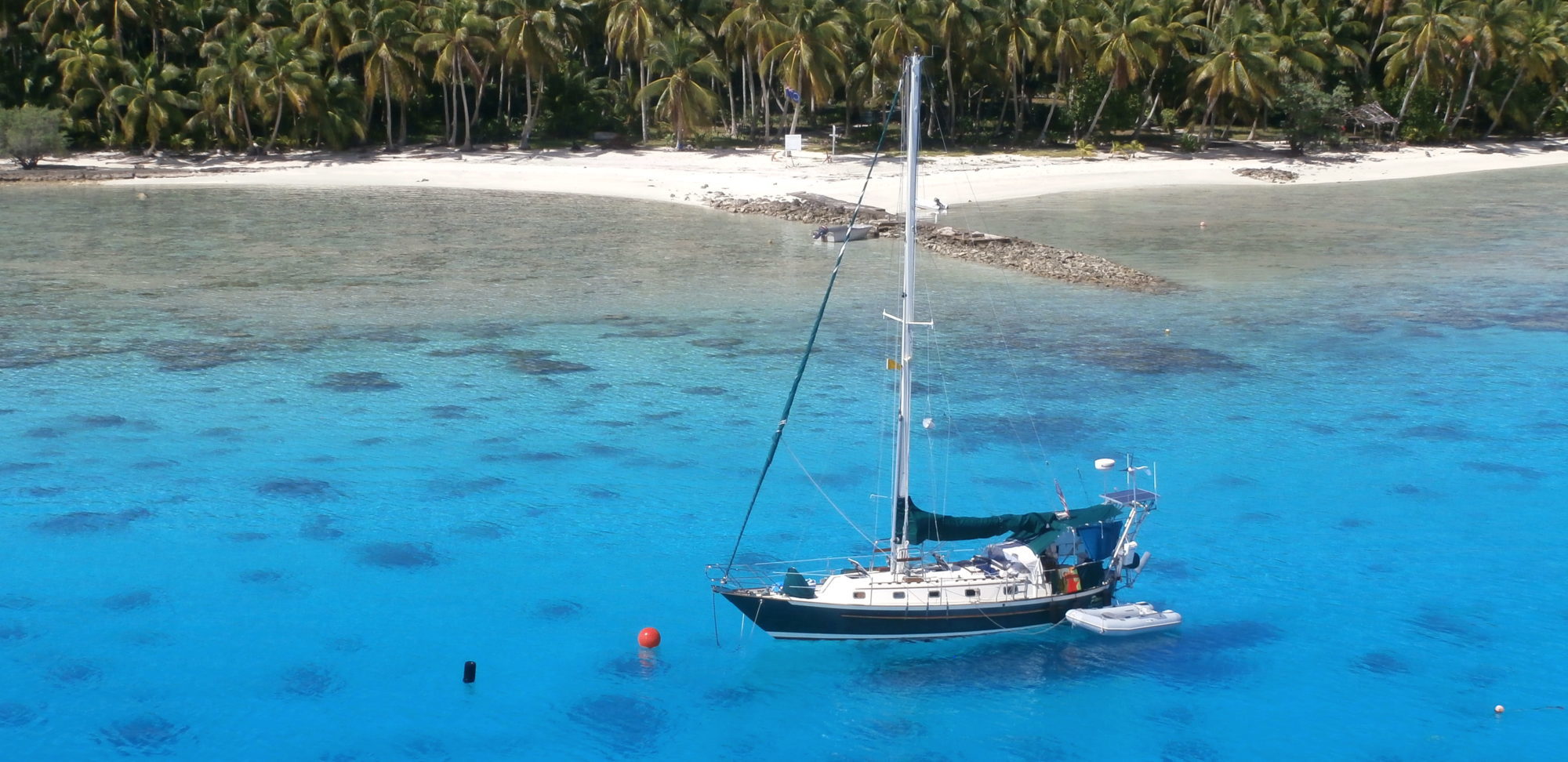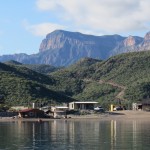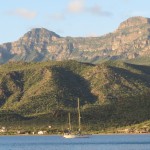At 11:00 a.m. the sun was starting to get hot and the shade of the Dockside cafe looked pretty good. A cold drink was in order. I heard English spoken in the corner at a table overlooking the little harbor.
The two men were indistinguishable from each other, both in their mid-sixties, portly and bearded, with gray pony tails, khaki cargo shorts, and Hawaiian shirts. The woman sitting with them was similar, minus the beard.
“I’m gonna have me one more beer then go have my afternoon nap,” announced one of the men. “That’s what I’m gonna do today.” His face brightened into a broad grin about the day’s plan.
“I’ll do the same,” said the other man.
They laughed heartily for a moment, then paused as a dinghy with a small noisy outboard motor put-putted out of the harbor.
“Two stroke,” said the woman.
They say there’s tar at the bottom of the anchorage in La Paz, Mexico, and if you try to raise your anchor the tar holds you fast. The bottom is actually sand, good holding, with a tidal current that swings your boat in a circle twice each day. There are lots of boats in the free anchorage, and they swing independently through the current in a movement called “the La Paz waltz.”
There are beautiful old-style yawls and sleek modern Beneteaus sharing the anchorage with derelict dismasted boats that have turned into barnacle-encrusted havens for pelicans. The pelicans are quiet and stately, albeit numerous, and deserve a peaceful place to rest, so the derelict boats serve as an ornithological sanctuary. Or an eyesore. The anchorage is well protected in a long estuary. It’s a convenient place to set your anchor for a while, maybe years, making the easy trip to the dinghy dock the primary event of the morning.
The primary event of the evening, of course, is bringing in the dinghy for a trip to Rancho Viejo for arachera, a high grade of carne asada, tucked into a taco de mais and smothered with chili peppers, accompanied by an ice-cold Negra Modela.
It was time for a pause. We had sailed nearly 1000 miles down the Baja peninsula, around the cape, and up into the Sea of Cortez. We had endured four days tied up to a pier in Cabo San Lucus, where, because of my shaggy hair and scraggly beard I’d been offered every kind of illicit drug by the various street merchants pretending to sell Cuban cigars.
“Hola, amigo. Pssst … I got it!”
“Got what?”
“I got it.” Wink wink. He deftly turned the cigar box over to reveal what was hidden on the other side. He definitely had it.
“Pam, he’s got it.”
“What? Got what?”
“Should we get some?”
“What are you talking about?”
Pam was oblivious to the street offers happening with regular frequency on either side as we strolled along the wharf.
We sailed into La Paz with about fifteen other boats that we recognized from the Baja Ha-Ha. Mintaka, Maluhia, Celebration, Betty Jane, Tillie, Cygnus, Ariel 4, some in the marina, some anchored out.
“What are your plans?” I asked everyone.
“No plans at the moment,” was a common reply.
“We’re going to sail out to Espiritu Santo and Isla Partida, probably anchor in Caleta de Partida to tuck in against the swell from the southwest, then tack up to San Francisco, San Jose, hopefully as far as Agua Verde before we have to turn around.”
“Oh.”
Maybe I was over-thinking it. Everyone was ready for a good long pause but I was still making travel plans.
Our few days in La Paz were not much of a pause. I was still in “get it done” mode. I had the propane topped up and the zinc replaced on the end of the propeller. We spent a half a day at the TelCel store to get our Banda Ancha 3G device to plug into the Mac — this would provide internet while in proximity of any town with a cell tower. We roamed the streets for fresh produce and discovered the side street where the local organic farmers sell fresh lettuce, basil, and cilantro. Our efforts to find a good cappuccino had paid off. Now it was time to move on and see the Sea of Cortez.
We rode a southerly up to San Evaristo, a tiny fishing village about 60 miles north of La Paz on a crescent of sand surrounded by tall mountains. Then the grand tour was interrupted by a northerly blowing gusts up to 30 knots down the Sea. Back in San Francisco Bay, a day sail with 30 knots is somewhat common. But going north up the Sea banging into waves and wind that high is a big deal, and the advice from sonrisanet, a Ham radio frequency with regular forecasts for the Sea of Cortez, was to find a protected anchorage to sit out the three-day blow.
We met Walter on the beach at San Evaristo and he helped us buy a fish.
“La pescadero es se vender?” I queried a fisherman who was cutting up a fish under a palm frond shelter. My Spanish is bad and getting worse. I was asking the fisherman whether he was putting himself up for sale.
Walter intervened, explaining that these fish belonged to someone else and the fish-cleaning crew were actually hired to clean the fish. The fish were to be taken to La Paz and sold.
“They brought in a nice halibut this afternoon. I would hold out for the halibut,” Walter advised. He was the spitting image of an elderly David Crosby (of Crosby, Stills, and Nash) with a Crosby-esque mischievous twinkle in his eye. He was from Santa Barbara but and had been coming down to Baja and San Evaristo for the past 50 years. The fisherman on the beach knew him well.
He led us a short way down the beach to speak with a man sitting in the shade of a small concrete-block building. He seemed to be haggling with the man about the halibut.
“I think you could get it for 50 pesos,” he coached. About four dollars, a good price for a fresh-caught fish. “I want to get a little piece of it for sashimi.” The man took the halibut out of an ice chest in the back of a pickup truck and showed it to us. It was a nice five-pound fish. Best of it, it was a white fish, not like the oily blood-red skip jacks I had been catching on my hand line.
Pam pulled out a 200-peso note to pay the man but he frowned. Walter explained that the man could not break the 200-peso note. Then Walter made a deal with Pam for his sashimi. “Look,” he said. “You give me your 200-peso note and I’ll give you back two 100-peso bills plus a 10-peso coin.” The haggling in Spanish and the mathematics seemed to confuse us. Were we getting ripped off somehow? This was turning into a minor adventure, and I decided to run with it.
“Will they clean and filet the fish for us?” I asked. Walter translated this to the man and the man pointed at two other fisherman standing about. One of the fishermen had a hard unfriendly look, a lean muscular build, and a brand new pair of yellow rubber boots. He took out his filet knife and began working on the fish, deftly cutting along the spine and removing the bones, using a garbage can lid as a table. Pam blanched as he tossed the filets on the unclean surface. I noticed that he placed them skin-side down, keeping the meat clean. He delicately cut between the skin and the flesh, then handed me each clean filet to place into a plastic bag. His hard look dissolved as I handed him a 20-peso note and respectfully thanked him for his work.
Walter got a small piece for his sashimi. I wasn’t satisfied with this. After all, he had advised us as to where and how to get the best fish, he had secured for us a nice deal, and had provided translation services. I asked señor yellow-boots to cut one of the filets in half, then gave it to Walter as a tip. He smiled broadly, and now we were all smiling. Walter took his sashimi back to his camper, a small pickup with a shell and a hard-bottom dinghy on top. He was definitely taking a pause.
I wondered what I would do for four days in San Evaristo. We prepared the halibut, kayaked around the small bay, snorkeled on the rocks by the point, and simply watched the days go by. As the sun rose each morning, the jagged mountains to the west turned red. The clarity of the morning light showed every crevice, ridge, and valley of that rugged range. The wind grew stronger as the days passed and the boat sailed around on its anchor, but we were secure and happy.
A few days later we were back in La Paz. We anchored next to one of our new friends, then met all of the others as we paddled the kayak to the dinghy dock in the marina. How magical to see our friends again! We had sundowners and dinner on Celebration, ran a 6K fun run with Ariel 4 and saw a movie about their Northwest Passage (yes, they sailed from Sweden over the top of North America to join the Baja Ha-Ha fleet in San Diego), went out for arachera with Mintaka and Maluhia, had a guitar jam with Cynus, chatted with Betty Jane in the market, and delivered a gift of fresh bagels to Tillie. We made new friends as we joined a guitar jam on Rapscullion. We entertained our friends, old and new, with tales from the north, about Isla Partida, San Evaristo and the halibut.
What was the news from La Paz? we asked them.
“Not much. It got windy.”



Enjoying your musings, Cap’n Dennis.
Fair winds, stay safe and…
Feliz Navidad!
Bill & Kathleen
Merry Christmas! Almost feels like I’m there with you!
Merry Christmas guys!
And happy new year, too!
Hi Pam and Dennis! Couldn’t resist peeking in on your travels before running off to see kids. Glad to know you’re well and warm. Love to you both!!!!!